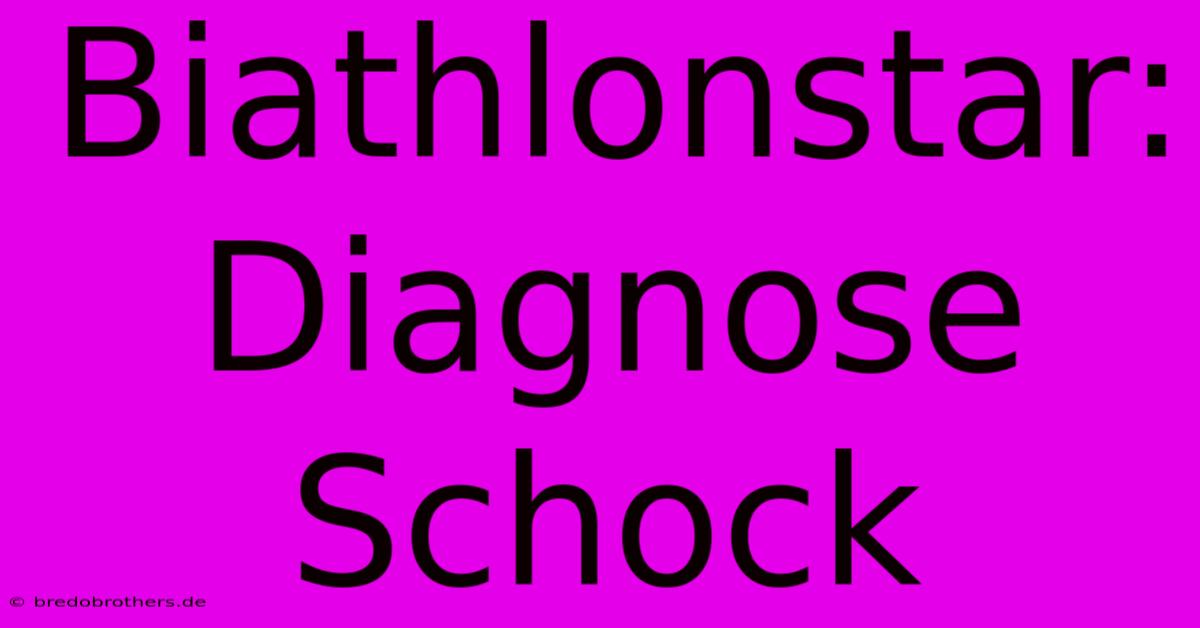Biathlonstar: Diagnose Schock

Discover more detailed and exciting information on our website. Click the link below to start your adventure: Visit Best Website Biathlonstar: Diagnose Schock. Don't miss out!
Table of Contents
Biathlonstar: Diagnose Schock – Ein Schock für Fans und Athleten
Man, oh man. This one hit hard. Remember when I was telling you about how I totally thought I was going to qualify for the regional biathlon championships? Yeah, that didn't exactly go as planned. Turns out, my meticulously crafted training schedule – which, let me tell you, involved a lot of early morning runs and frankly, questionable amounts of coffee – was completely derailed by something far bigger than a missed shot or a wobbly ski. It was a diagnosis shock, and it totally blindsided me.
The Day Everything Changed
It started subtly. A nagging ache in my knee. I figured it was just overuse. I'm a stubborn, driven athlete, you know? I powered through. I mean, I am a competitive biathlete, so ignoring pain is kinda my specialty, right? Wrong. Very, very wrong.
Ignoring it led to a whole cascade of problems. The ache became a sharp pain, then a throbbing, debilitating agony. My performance tanked – I was missing targets left and right, and my skiing form became…well, let's just say it looked less like graceful gliding and more like a penguin having a seizure. This wasn't just about my personal goals; this affected my whole team. Teamwork is essential in biathlon, and I felt terrible letting them down.
Eventually, I had to see a doctor. The diagnosis? A partially torn meniscus. Seriously?! My whole world tilted on its axis. Partially torn meniscus? That’s not something you just “power through.” That's serious stuff. I was gutted. Months of training, thrown down the drain. This wasn't just about the regional championships, this was about my future in biathlon.
Learning the Hard Way: Lessons from a Diagnosis Shock
This whole experience, though brutal, taught me some valuable lessons. Firstly, listening to your body is non-negotiable. I know, I know – we all push our limits, especially in competitive sports. But there's a crucial difference between pushing through minor aches and ignoring serious pain. Ignoring pain just leads to bigger problems. This is applicable to all aspects of life, really; don’t ignore signs of trouble.
Secondly, prevention is key. Proper warm-ups, cool-downs, and a well-structured training plan with adequate rest days are crucial. Trust me, I wish I’d taken this more seriously earlier. My haphazard training schedule was a major contributing factor to my injury.
Beyond Physical Health: The Mental Game
Then, of course, there's the mental side of things. The initial shock of the diagnosis hit me hard. Feeling like you've failed, that your dreams are crumbling… it's crushing. I felt really let down; I’d put so much into my training.
But you know what? It's important to remember that setbacks are a part of life, especially in a sport as demanding as biathlon. I started focusing on my recovery, and found that this unexpected break also provided valuable time for mental restoration and reframing my goals.
Rebuilding and Moving Forward
I'm currently in physical therapy. The recovery process is long, but I’m making progress. I’m taking each day, each training session as it comes. I am stronger now, both physically and mentally. I am working on rebuilding my strength, getting back into shape, and improving my overall conditioning for next year’s biathlon season. The injury was a shock, but it's made me a better athlete, more aware of my body's needs, and more resilient in the face of adversity.
Keywords: Biathlon, injury, diagnosis, meniscus tear, sports medicine, recovery, training, athlete, setback, resilience, mental health, physical therapy.

Thank you for visiting our website wich cover about Biathlonstar: Diagnose Schock. We hope the information provided has been useful to you. Feel free to contact us if you have any questions or need further assistance. See you next time and dont miss to bookmark.
Featured Posts
-
Bayern Vs Augsburg Liveticker Bundesliga Spieltag 11
Nov 23, 2024
-
Trump Nominiert Bondi Sehr Kurz Fokus Auf Trump
Nov 23, 2024
-
Premier League Deutscher Erfolg Dank Darts Legende
Nov 23, 2024
-
Yamal Psg Barca Luege Oder Wahrheit
Nov 23, 2024
-
Waffenstillstand Libanon Israel Protestiert
Nov 23, 2024
